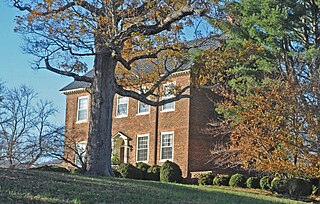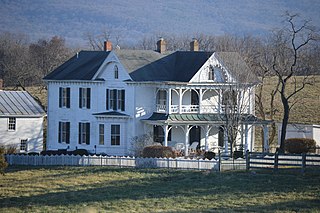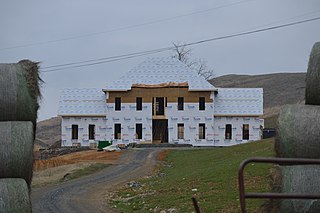
Fancy Farm is a historic plantation house located at Kelso Mill, near Bedford, Bedford County, Virginia. It was built about 1785, and is a two-story, five bay brick dwelling in the Late Georgian style. It has a metal gable roof and two interior end chimneys. The interior features original woodwork. The house was restored in 1969–1971. Also on the property are a contributing brick storehouse, a frame kitchen with a stone chimney, and a frame quarters also with a stone chimney. The property features a panorama of the Peaks of Otter. Fancy Farm was used as the headquarters of Union General David Hunter in his Lynchburg campaign during the Valley Campaigns of 1864.

Phlegar Farm is a historic home located near Floyd, Floyd County, Virginia. The original log dwelling was built in 1816, and later expanded about 1857 and about 1910. The house is two-stories with a metal sheathed gable roof, weatherboard siding, a stone gable-end chimney, two one-story front porches, and a one-story ell. The interior has Federal and Greek Revival style details. Also on the property are a contributing granary and workshop.

Rock Castle is an historical estate located at Rock Castle, Goochland County, Virginia. Located on the Rock Castle property is the Queen Anne Cottage. It is a small, five-bay, 1+1⁄2-story frame structure with clipped gable ends and two interior end chimneys. The house was built prior to 1732. In 1843 Rock Castle was purchased by John Rutherfoord, Governor of Virginia from 1841 to 1842.

Furr Farm is a historic home and farm located at Aldie, Loudoun County, Virginia. The house is a two-story, five-bay, frame structure with a side gable roof and exterior end chimneys. The property includes two contributing frame barns.

James Charlton Farm is a historic home located near Radford, Montgomery County, Virginia. The house dates to the early-19th century, and is a two-story, square, log dwelling with a four-room plan. It is sheathed in weatherboard, and features a pair of coursed rubble double-shouldered chimneys linked by a stone wall approximately five feet high. Also on the property are the contributing coursed rubble stone chimney, a board-and-batten meathouse, a frame drive-through corn crib, a frame barn, and two frame garages.

Beaumont is a historic home located near Michaux, Powhatan County, Virginia. It consists of a two-story, five-bay, central-passage frame structure built in 1811, with a two-story rear brick addition built about 1839. The front facade features a two-tier portico. The main block has a gable roof and exterior end chimneys. The property was acquired in 1937 by "Beaumont Farms" as a reform school for boys. The property is under the jurisdiction of the Virginia Department of Corrections and serves as the Beaumont Learning Center.

Linden Farm, also known as Linden and Dew House, is a historic home located near Farnham, Richmond County, Virginia. It was built in two stages between about 1700 and 1725, and is a small 1+1⁄2-story Colonial era frame vernacular dwelling. It is clad with beaded weatherboards and has an asymmetrical gable roof. The house features tall, asymmetrical, pyramidal brick chimneys.

Kennedy–Lunsford Farm is a historic home, farm, and national historic district located near Lexington, Rockbridge County, Virginia. The district encompasses six contributing buildings. The main house is built of stone. Additional buildings: a large bank barn, a corn crib / machinery shed, a spring house, a chicken coop and a syrup house, all date from the early 20th century.

Snapp House, also known as Wildflower Farm, is a historic home located near Fishers Hill, Shenandoah County, Virginia. It was built about 1790, and is a two-story Continental log dwelling sheathed in weatherboard. It sits on a limestone basement and has a two-story, rubble limestone rear ell with a central chimney. A small frame structure connects the log section to the rear ell. Also on the property is the contributing site of a spring house.

Clem–Kagey Farm, also known as the Hiram C. Clem House and Kagey House, is a historic home and farm located near Edinburg, Shenandoah County, Virginia. The farmhouse was built in 1880, and is a two-story, five-bay, frame I-house dwelling with an integral rear wing. It features a full width, two-story Italianate style ornamented front porch and two brick interior chimneys. Also on the property are the contributing frame garage (c. 1920, the two-story frame wagon shed/shop building, and granary.

George Oscar Thompson House, also known as the Sam Ward Bishop House, was a historic home located near Tazewell, Tazewell County, Virginia. It was built in 1886–1887, and was a two-story, three-bay, T-shaped frame dwelling. It had a foundation of rubble limestone. The front facade featured a one-story porch on the center bay supported by chamfered posts embellished with sawn brackets. Also on the property were a contributing limestone spring house, a one-room log structure, and a 1+1⁄2-story frame structure. Tradition suggests the latter buildings were the first and second houses built by the Thompson family.

James Wynn House, also known as the Peery House, is a historic home located near Tazewell, Tazewell County, Virginia. It was built about 1828, and is a large two-story, three-bay, brick dwelling with a two-story rear ell. The main block has a gable roof and exterior end chimneys. Across the front facade is a one-story, hip-roofed porch.

The Walter McDonald Sanders House is a historic house that forms the center of the Sanders House Center complex at Bluefield in Tazewell County, Virginia, United States. It was built between 1894 and 1896, and is a large two-story, three-bay, red brick Queen Anne style dwelling. A two-story, brick over frame addition was built in 1911. The house features a highly decorative, almost full-length, shed-roofed front porch; a pyramidal roof; and a corner turret with conical roof. Also on the property are the contributing limestone spring house, a frame smokehouse which contains a railroad museum, a frame granary, and an early-20th century small frame dwelling known as the Rosie Trigg Cottage, which houses the Tazewell County Visitor Center.

The Williams House, also known as the Clinch Valley Coal and Iron Company Office, is a historic home and office located at Richlands, Tazewell County, Virginia. It was built in 1890, and is a 2+1⁄2-story, frame Georgian Revival style dwelling. It has a hipped roof with pedimented dormers and features a one-story, hip-roofed front porch supported by six slender Tuscan order columns. It originally served as the office for the Clinch Valley Coal and Iron Company, developer of Richlands. The building was sold in 1901 to Dr. William R. Williams, who used it as a residence. In 1984, it became the location of the town's branch of the Tazewell County Public Library.

Maiden Spring is a historic home and farm complex and national historic district located at Pounding Mill, Tazewell County, Virginia. The district encompasses eight contributing buildings, two contributing sites, and one contributing structure. The main house consists of a large two-story, five-bay, frame, central-passage-plan dwelling with an earlier frame dwelling, incorporated as an ell. Also on the property are the contributing meat house, slave house, summer kitchen, horse barn, the stock barn, the hen house, the granary / corn crib, the source of Maiden Spring, the cemetery, and the schoolhouse. It was the home of 19th-century congressman, magistrate and judge Rees Bowen (1809–1879) and his son, Henry (1841-1915), also a congressman. During the American Civil War, Confederate Army troops camped on the Maiden Spring Farm.
Indian Paintings is a historic archaeological site located near Maiden Spring, Tazewell County, Virginia. These pictographs are on a rock face high on Paint Lick Mountain. Stretched in a horizontal line along the irregular exposure is a series of simple images representing thunderbirds, human figures, deer, arrows, trees, and the sun, all painted in a red medium using iron oxide.

Fairview Farm is a historic home located near Front Royal, Warren County, Virginia. It was built during the last quarter of the 18th century, and is a two-story, nearly square, timber frame dwelling. It has a hipped roof and two exterior chimneys. It also has two-story porches rebuilt during the restoration in 1984.

Crabtree–Blackwell Farm is a historic farm located near Blackwell, Washington County, Virginia. The main house is a "saddlebag" type building with 2 1/2-story pens connected by a central limestone rubble chimney stack. The remaining Appalachian vernacular contributing resources are a spring house or milkhouse and log hay barn. The farm is representative of mountain folk culture.

Boush–Tazewell House is a historic home located at Norfolk, Virginia, USA. It was built about 1783–1784, and is a two-story, Georgian frame house, five bays wide and two bays deep, with a slate covered deck-on-hip roof. It has a two-level, tetrastyle pedimented portico supported by slender Tuscan order columns on both levels. It originally stood in downtown Norfolk and was completely dismantled and re-erected in its present location around 1902. The house was purchased in 1810 by Congressman, Senator and Governor Littleton Waller Tazewell (1775-1860). His family continued to occupy the house until 1894.
Bayville Farm, also known as Church Point Plantation and Bayside Plantation, was a historic plantation house located at Virginia Beach, Virginia. The house was built in 1827 and enlarged in the 1840s, and was a two-story, five-bay, two-story, double-pile, frame structure with brick ends. It had a basement laid in three-course American bond. It had pedimented tetra-style Roman Doric order porch at each entrance and four interior end chimneys. It was destroyed by fire in 2007.






















